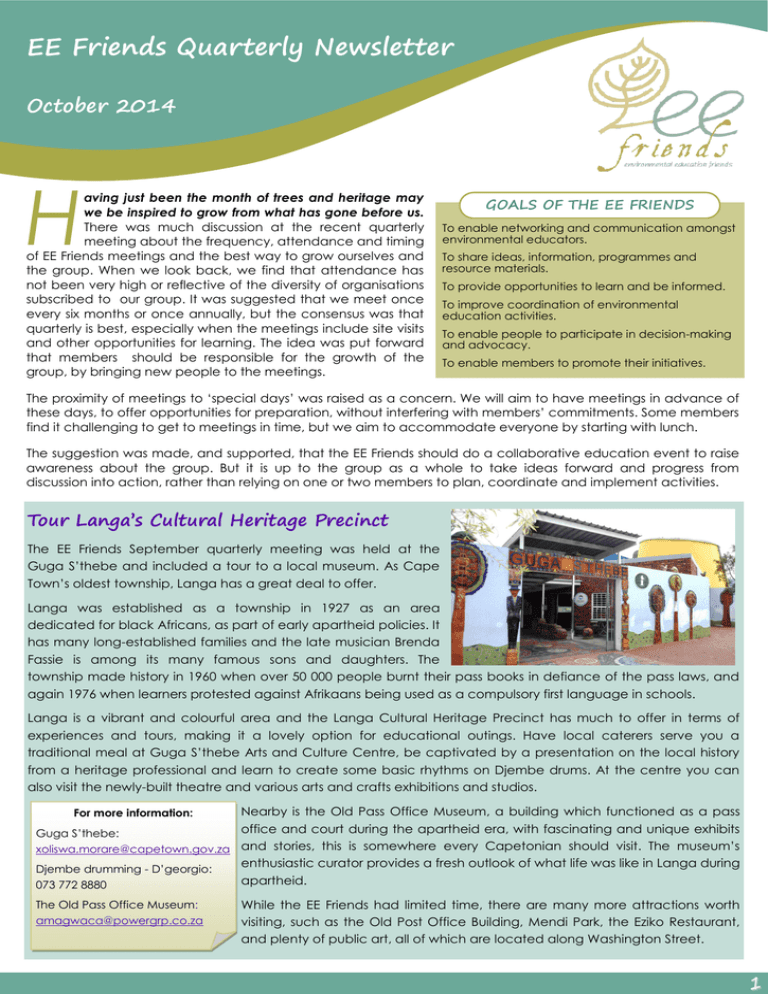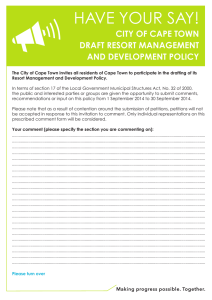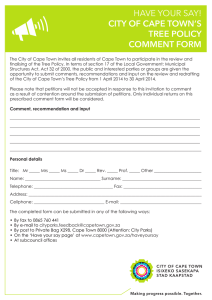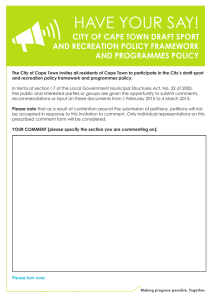H EE Friends Quarterly Newsletter October 2014
advertisement

EE Friends Quarterly Newsletter October 2014 H aving just been the month of trees and heritage may we be inspired to grow from what has gone before us. There was much discussion at the recent quarterly meeting about the frequency, attendance and timing of EE Friends meetings and the best way to grow ourselves and the group. When we look back, we find that attendance has not been very high or reflective of the diversity of organisations subscribed to our group. It was suggested that we meet once every six months or once annually, but the consensus was that quarterly is best, especially when the meetings include site visits and other opportunities for learning. The idea was put forward that members should be responsible for the growth of the group, by bringing new people to the meetings. GOALS OF THE EE FRIENDS To enable networking and communication amongst environmental educators. To share ideas, information, programmes and resource materials. To provide opportunities to learn and be informed. To improve coordination of environmental education activities. To enable people to participate in decision-making and advocacy. To enable members to promote their initiatives. The proximity of meetings to ‘special days’ was raised as a concern. We will aim to have meetings in advance of these days, to offer opportunities for preparation, without interfering with members’ commitments. Some members find it challenging to get to meetings in time, but we aim to accommodate everyone by starting with lunch. The suggestion was made, and supported, that the EE Friends should do a collaborative education event to raise awareness about the group. But it is up to the group as a whole to take ideas forward and progress from discussion into action, rather than relying on one or two members to plan, coordinate and implement activities. Tour Langa’s Cultural Heritage Precinct The EE Friends September quarterly meeting was held at the Guga S’thebe and included a tour to a local museum. As Cape Town’s oldest township, Langa has a great deal to offer. Langa was established as a township in 1927 as an area dedicated for black Africans, as part of early apartheid policies. It has many long-established families and the late musician Brenda Fassie is among its many famous sons and daughters. The township made history in 1960 when over 50 000 people burnt their pass books in defiance of the pass laws, and again 1976 when learners protested against Afrikaans being used as a compulsory first language in schools. Langa is a vibrant and colourful area and the Langa Cultural Heritage Precinct has much to offer in terms of experiences and tours, making it a lovely option for educational outings. Have local caterers serve you a traditional meal at Guga S’thebe Arts and Culture Centre, be captivated by a presentation on the local history from a heritage professional and learn to create some basic rhythms on Djembe drums. At the centre you can also visit the newly-built theatre and various arts and crafts exhibitions and studios. Nearby is the Old Pass Office Museum, a building which functioned as a pass office and court during the apartheid era, with fascinating and unique exhibits Guga S’thebe: xoliswa.morare@capetown.gov.za and stories, this is somewhere every Capetonian should visit. The museum’s enthusiastic curator provides a fresh outlook of what life was like in Langa during Djembe drumming - D’georgio: apartheid. 073 772 8880 For more information: The Old Pass Office Museum: amagwaca@powergrp.co.za While the EE Friends had limited time, there are many more attractions worth visiting, such as the Old Post Office Building, Mendi Park, the Eziko Restaurant, and plenty of public art, all of which are located along Washington Street. EE Events and Projects Gallery In Arbor week 363 learners participated in special Arbor lessons in Kirstenbosch, including learners from Parkfields Primary (left), who were sponsored by the Gold Fields Centre, and Kuyasa Primary (right). Learners from Greenlands Primary School painting with ochre and feathers, in one of the City of Cape Town’s Heritage Month learner programmes (25 September) The EE Friends enjoying a cultural heritage experience, in a drumming session at the Heritage Month quarterly meeting (16 September). Kirstenbosch National Botanical Garden staff help learners from the Athlone School for the Blind plant orange trees (3 September) Share your work and exciting activities with us Email photos with captions to EE.Friends@capetown.gov.za PSP recently launched a new clay technology learner book Approximately 40 teachers attended the launch, and the initiative has thus far been found to be a success. "Learning about Traditional Pottery" is the first project book for Intermediate Phase learners in the PSP project book series on Indigenous Knowledge and Science. These project books are written for learners, with teacher/ caregiver facilitation. A few of the 238 Hindle Road High School grade 11 learners that visited Kirstenbosch Gardens as a part of their Climate Change Week programmes in August. This book offers practical activities using clay, where children can learn about the development of indigenous clay technology in South Africa, as well as the science of how clay is made into beautiful pottery and ceramics. Members’ Survey Findings Only 24 of our 120+ members (20%) participated in the survey. TOP reasons to be a member 3 Networking opportunities Share knowledge and experience All four times a year 9% I’m new 26% Three times a year 13% Get ideas for EE programmes Suggestion: Seek new contacts, expand the group and encourage more active participation and attendance 75% felt that enough emails are being distributed to the mailing list, while 65% felt that at least half of the emails are relevant and/ or useful. 3 How often do you attend EE Friends meetings? OUR MEETINGS ARE ON TRACK TOP items that a meeting should include Resource sharing session Members sharing projects and events Presentations 3 Twice a year 17% Never 13% Once a year 22% Only 22% attend more than two meetings per year, 39% attend once or twice and 13% never attend. The main reason was a lack of time. TOP Suggestion: Have after-hours events, workshops, etc. Site visits and excursions More learning opportunities More networking opportunities Suggestion: Have tangible initiatives or projects things that would make you more likely to participate The majority felt the EE Friends should produce a quarterly newsletter (86%) and various suggestions were made, almost all of which were incorporated into our design. What will YOUact do to on these findings? Interested in doing a digital survey? www.surveymonkey.com Check These Out For your classroom clay needs, contact Cape Pottery Suppliers for their 10kg Red School Clay, and ask for your school-use discount! www.capepotterysupplies.co.za Heart of Nature (coaching and experiences inspired by nature) now has a website. heartofnature.co.za An exciting website has been launched for educators, trainers and parents to download environmental ‘edutainment’ resources, such as illustrated stories, CAPS linked learning materials, and much more. www.ecology.co.za Member Profile: The Cape Leopard Trust T he Cape Leopard Trust is a n o n ‐ p r o f it o r ga n i s at i o n , launched in 2004 as an active predator conservation group in the Cape. It uses research as a tool for conservation, seeks human‐ wildlife conflict solutions and inspires interest in the environment through education. The EE programme runs camps, outings and eco‐clubs, that explore the environment through experiential learning. It incorporates cutting-edge research on leopard and caracal, using the charismatic Cape leopard as a flagship species to stimulate conservation awareness and action. lasting networks and partnerships. They aim to create interactive and explorative learning experiences for all students that they work with, by getting them out into nature and having fun while learning. They aim to immerse children in nature, allowing them to learn to love and enjoy being outdoors, and appreciate and respect their natural environment. CLT offers a range of hikes, outings and excursions for schools around the Cape, as well as supporting schools with learning programmes, eco‐ Aims for the education programme As CLT expands, it hopes to work with NGOs, schools, educators and a broader network, to create long clubs, outdoor extra murals and presentations. For more information, visit their website www.capeleopard.org.za, or contact: Jaclyn Stephenson capetown@capeleopard.org.za Hadley Lyners education@capeleopard.org.za Elizabeth Martins elizabeth@capeleopard.org.za The Lighter Side Can you guess the Cape heritage site? http://en.wikipedia.org/wiki/List_of_heritage_sites_in_the_Cape Noon Gun, Signal Hill Clock Tower, V&A Waterfront Robben Island Answers: Our Next Quarterly Meeting: 27 November 2014 Focus on Waste, in celebration of Buy Nothing Day Venue to be decided, suggestions and contributions are welcome. Seeking Partnerships A representative from the Langa Beautification Project shared at the recent meeting. If anyone would like to support the project, contact: Ntsikelelo Gum Tel: 021 694 2441 Fax: 021 694 2441 Cell: 078 265 1426 Email: gntsikelelo@gmail.com EE Friends is an informal network of individuals and organisations involved in Environmental Education in and around Cape Town; without a constitution, office-bearers or membership fees. For more information please visit www.capetown.gov.za/EEFriends. If you would like to know more or become a member of EE Friends, please contact: Mrs Skye McCool Tel: +27 (0)21 487 2318 E-mail: ee.friends@capetown.gov.za







